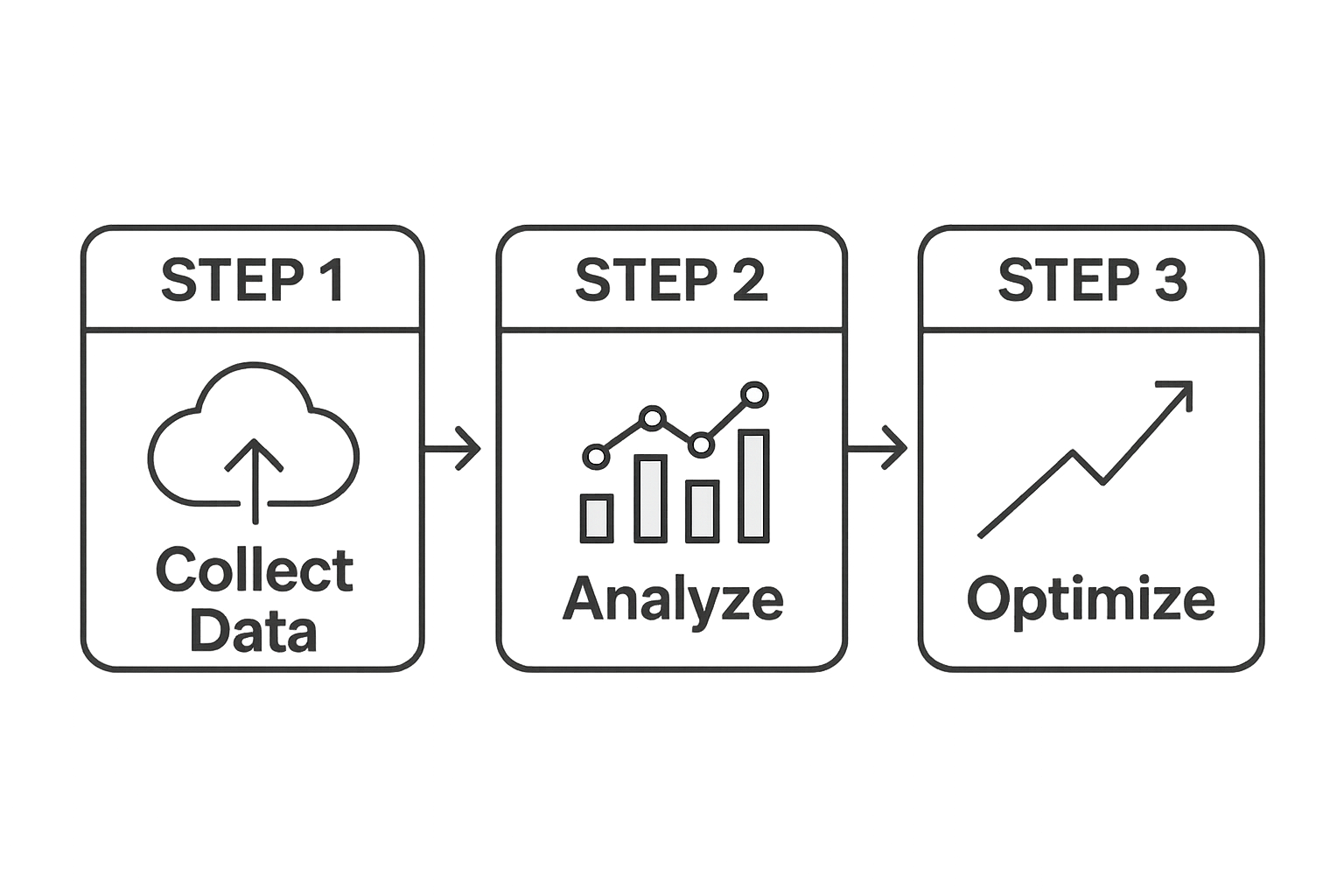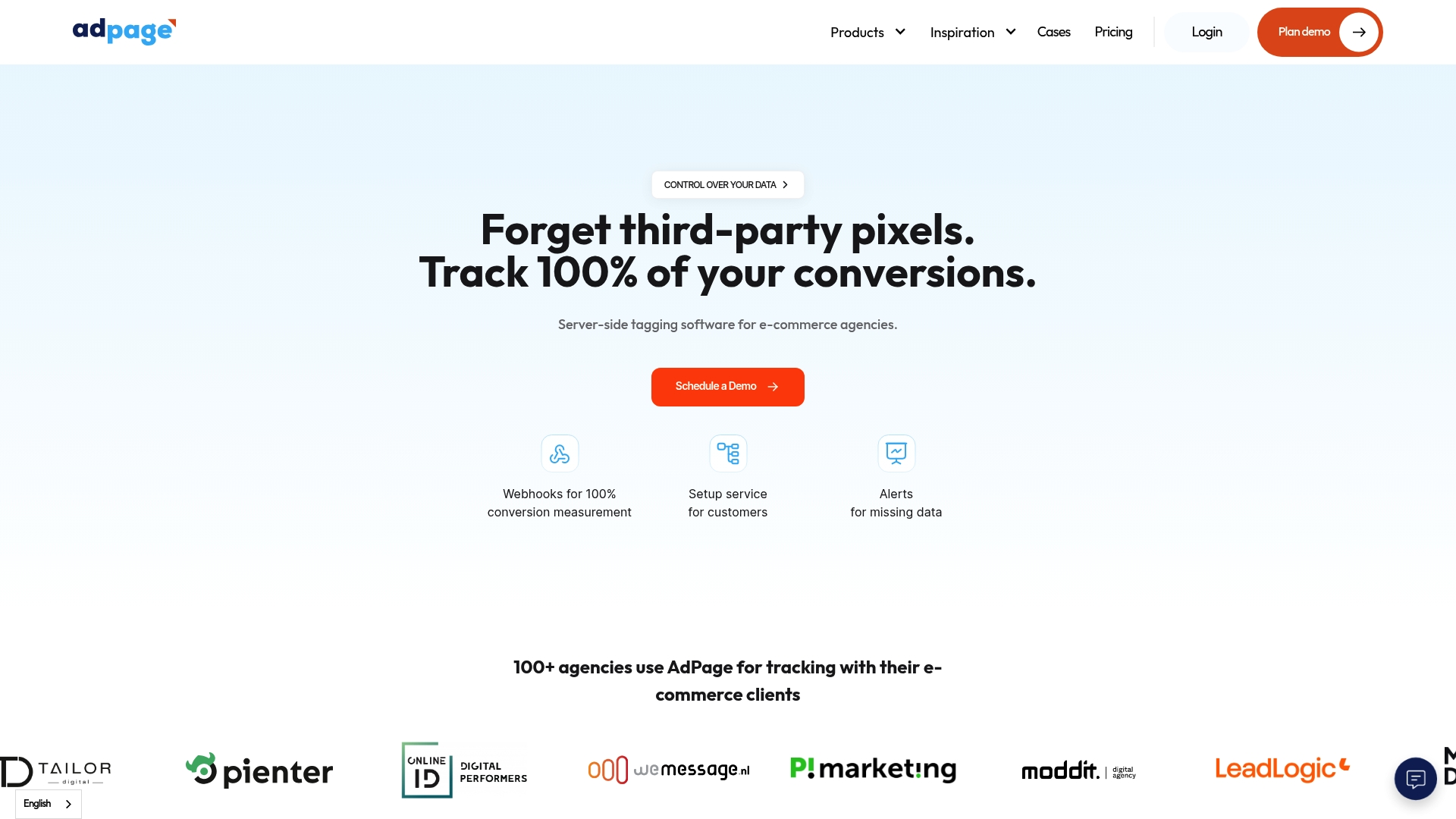Tracking your visitors might sound straightforward. Yet shockingly, most businesses focus on vanity numbers like page views and miss what truly matters. When you realise that actionable metrics directly linked to business outcomes are what drive real growth, it changes your entire approach to data collection and conversion strategy.
Table of Contents
- Step 1: Define Your Data Objectives And Metrics
- Step 2: Set Up Data Collection Tools And Platforms
- Step 3: Analyse Visitor Data For Insights
- Step 4: Implement Data-Driven Changes To Your Strategy
- Step 5: Test And Verify The Impact Of Changes
Quick Summary
| Key Point | Explanation |
|---|---|
| 1. Define Clear Data Objectives | Specify key conversion goals to guide data collection effectively. |
| 2. Use Robust Data Collection Tools | Implement server-side tracking for comprehensive insights while ensuring user privacy. |
| 3. Analyse Data for User Behaviour Insights | Segment visitor data to identify patterns and conversion barriers effectively. |
| 4. Implement Data-Driven Changes | Use A/B testing to validate strategies aimed at improving user engagement and conversions. |
| 5. Test and Verify Results Rigorously | Establish thorough testing protocols to ensure precise measurement of strategic impacts. |
Step 1: Define Your Data Objectives and Metrics
Successful data tracking begins with crystal clear objectives that transform raw visitor information into strategic insights. Your initial mission involves precisely defining what data points matter most for understanding user behaviour and driving conversions.
Start by mapping out the specific conversion goals for your digital platform. Are you aiming to increase product purchases, newsletter sign-ups, or reduce cart abandonment rates? Each goal requires targeted metrics that provide meaningful performance indicators. For e-commerce websites, this might include tracking average order value, conversion rate per traffic source, or customer lifetime value.
Carefully selecting your key performance indicators (KPIs) demands a strategic approach. Consider implementing our guide on creating actionable insights from data to refine your measurement framework. Effective metrics should be actionable, measurable, and aligned with business outcomes. This means moving beyond vanity metrics like total website visits and focusing on indicators that directly impact revenue and user engagement.
Your metric selection process should incorporate both quantitative and qualitative data points. Quantitative metrics might include conversion rates, bounce rates, and average session duration. Qualitative metrics could encompass user feedback, survey responses, and interaction patterns. By blending these perspectives, you create a comprehensive understanding of visitor behaviour.
Verify your objective setting by ensuring each metric answers three fundamental questions: What specific business goal does this metric support? How will tracking this metric inform decision making? Can this metric be consistently and accurately measured? If you cannot confidently answer these questions, refine your approach until you can.
Remember that data objectives are not static. Plan to review and adjust your metrics quarterly, allowing your tracking strategy to evolve alongside your business growth and changing market dynamics. Flexibility and continuous refinement are key to maintaining a robust data collection strategy that delivers genuine, actionable insights.
Step 2: Set Up Data Collection Tools and Platforms
With clear objectives established, the next critical phase involves implementing robust data collection infrastructure that captures comprehensive visitor insights. Your selected tools must provide granular tracking capabilities while maintaining user privacy and compliance standards.
Prioritise server-side tracking solutions that offer advanced data capture mechanisms beyond traditional browser-based analytics. These platforms enable more precise conversion tracking by collecting data directly through server interactions, minimising potential tracking disruptions caused by browser privacy settings or ad blockers. Learn more about implementing tracking systems for digital marketing success to understand the nuanced strategies behind effective data collection.
When selecting your data collection platforms, consider solutions that integrate seamlessly with your existing technology stack. Look for tools supporting multiple tracking methods, including pixel tracking, server-side tagging, and consent management frameworks. Key features should encompass real-time data processing, cross-platform compatibility, and robust privacy compliance protocols.
Configuring these platforms requires meticulous attention to technical details. Implement tracking codes across all critical user touchpoints such as product pages, checkout processes, and landing pages. Ensure each tracking implementation captures unique user identifiers, interaction timestamps, and relevant contextual information without compromising individual user anonymity.
Data privacy regulations demand transparent tracking practices. Configure explicit user consent mechanisms that clearly communicate what information is being collected and how it will be utilised. This approach not only ensures legal compliance but also builds user trust by demonstrating a commitment to responsible data handling.
Verify your tracking setup by conducting comprehensive testing across different devices and browsers. Create test scenarios simulating various user interactions to confirm data collection accuracy. Your verification process should validate that:* Conversion events are correctly recorded
- User journey data is comprehensively captured
- Performance metrics align with your predefined objectives
Remember that effective data collection is an ongoing process. Schedule regular audits of your tracking infrastructure, updating configurations to adapt to evolving technological landscapes and emerging privacy standards. A dynamic, flexible approach ensures your data collection remains precise, compliant, and genuinely insightful.
To help you implement robust visitor data capture, the table below summarises and compares key features to consider when selecting data collection tools and platforms.
| Feature | Description | Importance |
|---|---|---|
| Server-side Tracking | Captures data directly from server interactions | High: Ensures accuracy and minimises browser issues |
| Consent Management | Obtains explicit permission from users | Critical: Maintains privacy compliance |
| Real-time Data Processing | Provides immediate access to visitor data | Beneficial: Enables timely decision making |
| Cross-platform Compatibility | Works across desktop, mobile, and tablet | Vital: Ensures complete data coverage |
| Integration with Tech Stack | Seamlessly connects to existing systems | Efficient: Reduces technical complexity |
| Unique User Identification | Tracks users anonymously across sessions | Key: Supports reliable analysis without sacrificing privacy |
| Regular Auditing Capabilities | Allows for systematic review and update | Necessary: Maintains ongoing data quality |
Step 3: Analyse Visitor Data for Insights
Transforming raw visitor data into actionable strategic intelligence requires a systematic and nuanced analytical approach. Your objective is to uncover meaningful patterns that reveal user behaviour, preferences, and potential conversion barriers.
Learn more about interpreting complex user data and develop a comprehensive understanding of your digital audience. Begin by segmenting your visitor data across multiple dimensions such as traffic source, device type, geographic location, and engagement level. This granular analysis allows you to identify specific user groups with distinct behavioural characteristics and conversion potential.
Advanced segmentation enables you to pinpoint precise user journey variations. For instance, mobile users might demonstrate different interaction patterns compared to desktop visitors. By recognising these nuanced differences, you can develop targeted strategies that address specific segment needs. According to research on advanced analytics methodologies, cohort analysis provides deeper insights into user behaviour trajectories over time.
Utilise statistical techniques and visualization tools to transform complex data into comprehensible insights. Heat maps, conversion funnels, and user flow diagrams can reveal critical interaction points where visitors might disengage or encounter friction. Pay close attention to metrics like time on page, bounce rates, and conversion drop-off locations.
Your analysis should focus on identifying both positive performance indicators and potential improvement areas. Look for patterns that suggest successful conversion triggers as well as obstacles preventing user progression. This balanced approach ensures you can replicate successful strategies while systematically addressing conversion barriers.
Verify the effectiveness of your analysis by establishing a comprehensive review process. Create a structured framework to assess your findings:
- Quantify the potential impact of insights discovered
- Develop hypothetical optimization strategies
- Establish clear metrics to validate proposed changes
- Schedule regular review intervals to track performance
Remember that data analysis is an iterative process. Continuously refine your analytical approach, adapting to emerging user trends and technological advancements. Treat each dataset as a dynamic narrative that provides ongoing insights into user behaviour and potential conversion opportunities.

Step 4: Implement Data-Driven Changes to Your Strategy
Transitioning from data analysis to strategic implementation demands a calculated and systematic approach. Your insights must now transform into concrete, measurable changes that directly impact user conversion rates and overall digital performance.
Explore our comprehensive e-commerce data strategy guide to understand the nuanced approach required for successful digital transformation. Begin by prioritising insights with the most significant potential impact. Not all discovered patterns warrant immediate action, so focus on changes that promise substantial improvements in user experience and conversion potential.
Strategic implementation requires a methodical experimentation framework. Adopt an A/B testing methodology that allows you to validate hypotheses generated from your data analysis. This approach enables you to make incremental changes while measuring their direct impact on user behaviour. For instance, if your analysis revealed that mobile users experience higher drop-off rates during checkout, design targeted experiments to address potential friction points.
According to research on digital transformation strategies, successful organizations implement iterative changes with robust measurement protocols. Each modification should be accompanied by clear performance metrics and predetermined success criteria. This ensures that your strategic adjustments are objective and data validated.
Consider implementing changes across multiple dimensions:
- User interface and experience modifications
- Conversion funnel optimization
- Personalization strategies
- Pricing and promotional adjustments
- Communication and messaging refinements
Each strategic change must be tracked comprehensively, with precise monitoring of its impact on key performance indicators. Develop a dynamic feedback loop that continuously assesses the effectiveness of implemented changes. This means establishing real-time tracking mechanisms that provide immediate insights into how modifications influence user behaviour and conversion rates.
Verify the success of your implementation by creating a robust evaluation framework. This should include comparing pre and post-change metrics, assessing statistical significance of observed changes, and maintaining a comprehensive log of all strategic modifications. Your verification process ensures that each implemented change is objectively assessed, allowing for rapid iteration and continuous improvement of your digital strategy.

Step 5: Test and Verify the Impact of Changes
Rigorous testing serves as the critical validation mechanism that transforms hypothetical insights into measurable business improvements. Your goal is to systematically evaluate the effectiveness of strategic changes implemented in previous steps, ensuring data-driven decisions translate into tangible conversion enhancements.
Discover advanced A/B testing methodologies to refine your experimental approach and maximize statistical reliability. Implement a comprehensive testing framework that allows for controlled, precise measurement of each strategic modification. Controlled experiments are the cornerstone of meaningful data validation, providing empirical evidence of your strategic interventions.
According to research on digital optimization techniques, A/B testing provides a structured method for isolating the impact of specific changes. Design your experiments with meticulous attention to statistical significance, ensuring that observed variations are not merely random fluctuations but genuine performance improvements.
Your testing approach should encompass multiple dimensions of verification. Begin by establishing clear, measurable performance benchmarks against your original baseline metrics. Each test should target specific conversion objectives, whether improving user engagement, reducing cart abandonment, or enhancing overall user experience. Segment your testing across different user groups to understand nuanced variations in response to strategic changes.
Implement a comprehensive testing protocol that includes:
- Precise definition of test parameters
- Statistical significance thresholds
- Comprehensive performance metrics
- Controlled experimental conditions
- Defined testing duration
Utilise advanced statistical techniques to interpret test results, moving beyond surface-level observations. Calculate confidence intervals, conduct hypothesis testing, and assess the practical significance of observed variations. Robust statistical analysis transforms raw data into actionable insights, enabling you to make informed decisions about scaling or abandoning specific strategic modifications.
Verify the reliability of your testing process by establishing a structured review mechanism. This involves cross-referencing results across multiple testing cycles, identifying consistent patterns, and developing a systematic approach to strategic refinement. Your verification process should create a dynamic feedback loop that continuously validates and improves your conversion optimization strategy.
This checklist table provides a concise guide for verifying the impact of your strategic changes through controlled testing, ensuring each implementation is validated effectively.
| Verification Step | Key Action | Criteria for Completion |
|---|---|---|
| Define Test Parameters | Clearly state what is being tested | Test goals and variables are documented |
| Establish Baseline Metrics | Record original performance measurements | Baseline data collected for comparison |
| Set Statistical Significance Thresholds | Determine acceptable margin for confidence | Threshold agreed upon before testing |
| Segment Test Groups | Allocate users by traffic source or device type | Groups are clearly segmented and recorded |
| Monitor Real-time Results | Track ongoing data throughout test duration | Data is being captured without discrepancies |
| Analyse Results Using Statistical Techniques | Apply hypothesis testing and calculate confidence intervals | Findings show significant improvements or failures |
| Cross-reference Across Multiple Testing Cycles | Compare new results with previous test cycles | Consistent patterns are identified |
Transform Your Data Insights into Real Conversion Growth With AdPage
Are you tired of losing valuable sales because your analytics cannot capture the full visitor journey? When your business depends on understanding user behaviour and measuring every conversion, relying on browser-based tracking leaves dangerous gaps. You read how precision metrics and server-side data collection from the article prevent missed opportunities and unlock strategic growth. Now it is time to act on these insights.

Let AdPage give you peace of mind by helping you capture and analyse 100 percent of your conversions with robust server-side tagging and consent management. Seamlessly monitor all user actions, reduce data loss and integrate with platforms like Shopify or WooCommerce in just a few clicks. Take control of your e-commerce performance and ensure every marketing decision is backed by accurate data. Discover how AdPage makes your data actionable and trustworthy. Start your journey now at AdPage conversion solutions and never miss a conversion again.
Frequently Asked Questions
What are the key metrics to track for increasing conversions from visitor data?
It’s essential to focus on actionable metrics like conversion rates, average order value, customer lifetime value, and bounce rates. These metrics provide insights that directly impact your revenue and user engagement.
How can I ensure my data collection methods are compliant with privacy regulations?
Opt for server-side tracking solutions and implement clear user consent mechanisms. Communicate explicitly what data is collected and how it will be used to maintain compliance and build user trust.
What techniques can I use to analyse visitor data effectively?
Segment your visitor data by traffic source, device type, and engagement level. Use visualisation tools like heat maps and conversion funnels to identify user interaction patterns and potential conversion barriers.
How do I validate the impact of strategic changes on conversion rates?
Implement controlled A/B testing methodologies to measure the effectiveness of your changes. Establish clear performance benchmarks and analyse results with robust statistical techniques to ensure observed improvements are statistically significant.



.png)
